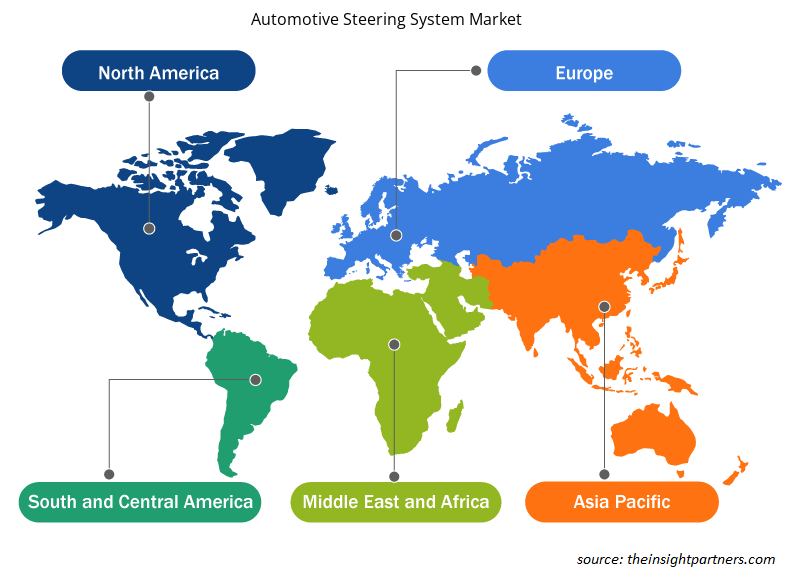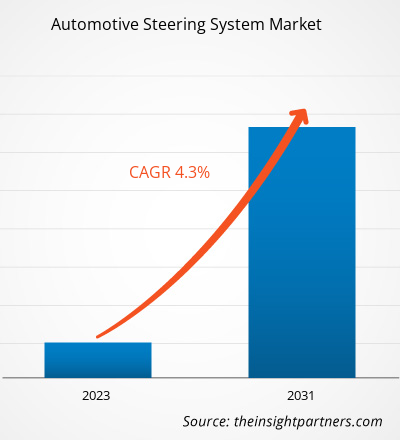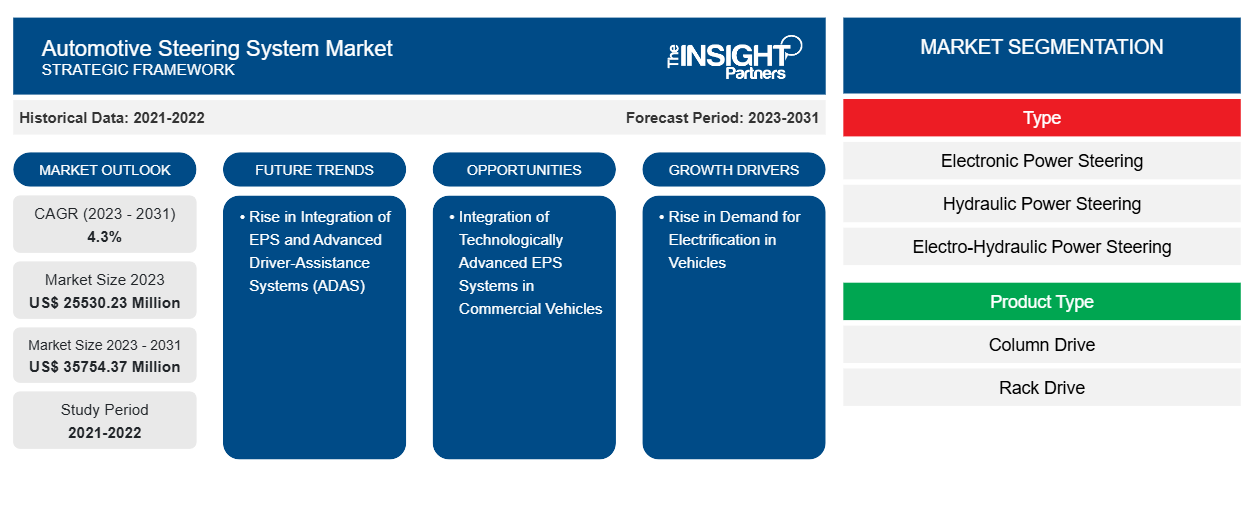من المتوقع أن يصل حجم سوق نظام التوجيه للسيارات إلى 35754.37 مليون دولار أمريكي بحلول عام 2031 من 25530.23 مليون دولار أمريكي في عام 2023. ومن المتوقع أن يسجل السوق معدل نمو سنوي مركب بنسبة 4.3٪ في الفترة 2023-2031. وقد سنت العديد من الحكومات في جميع أنحاء العالم تشريعات صارمة بشأن انبعاثات السيارات واقتصاد الوقود. وقد تم فرض لوائح على مستوى الأسطول من قبل هيئات تنظيمية مثل الإدارة الوطنية لحركة المرور والسلامة على الطرق السريعة في الولايات المتحدة والمجلس الدولي للنقل النظيف في أوروبا. يجب على مصنعي السيارات الالتزام بمتوسط سقف التلوث الذي تقرره هذه اللوائح. دفعت هذه اللوائح شركات صناعة السيارات إلى إنفاق المزيد في أنظمة التوجيه الموفرة للوقود مثل التوجيه الإلكتروني المعزز. على عكس أنظمة التوجيه الهيدروليكية التقليدية، فإن أنظمة التوجيه المعزز كهربائيًا أخف وزنًا ولها بنية أبسط.
تحليل سوق نظام التوجيه للسيارات
وفقًا لوزارة الطاقة الأمريكية، في ظل الظروف المثالية، يمكن لأنظمة EPS (التوجيه الإلكتروني) تحسين كفاءة الوقود بنسبة 2% إلى 4%، وتقليل استهلاك الوقود بنسبة تصل إلى 6%، وتقليل انبعاثات ثاني أكسيد الكربون بمقدار 8 جرام لكل كيلومتر. وفقًا لتقديرات شركة Nexteer Automotive Corporation، فقد وفرت أنظمة EPS ما يقرب من 3 مليارات جالون من الغاز منذ عام 1999. وعلى عكس الأنظمة الهيدروليكية، التي تضخ السوائل باستمرار عندما يعمل المحرك، فإن هذه الأنظمة تستخدم الطاقة فقط عند تدوير العجلات . تتمتع المنطقة الأوروبية بأعلى معدل انتشار للتوجيه الكهربائي، تليها أمريكا الشمالية ومنطقة آسيا والمحيط الهادئ. وبالتالي، من المتوقع أن تؤثر المعايير الحكومية الصارمة المختلفة لضمان كفاءة المركبات في استهلاك الوقود على الطريق على الطلب على أنظمة EPS، وبالتالي المساهمة في نمو السوق خلال فترة التوقعات.
نظرة عامة على سوق نظام التوجيه للسيارات
إن دمج إنترنت الأشياء في السيارات هو التطور الرقمي الكبير القادم في صناعة السيارات. إن ظهور المركبات ذاتية القيادة سيجلب ثورة أخرى في صناعة السيارات. إن المركبات ذاتية القيادة التي تم دمج نظام التوجيه الإلكتروني فيها (EPS) ستعزز تجربة القيادة للمستخدم. يوفر تطوير السيارات المتصلة فرصًا واعدة لكل من شركات التكنولوجيا وصناعة السيارات. إن تطوير المركبات المتصلة من شأنه أن يعزز استخدام نظام التوجيه الإلكتروني في المركبات، وبالتالي المساهمة في نمو سوق أنظمة التوجيه للسيارات العالمية خلال فترة التنبؤ.
قم بتخصيص هذا التقرير ليناسب متطلباتك
ستحصل على تخصيص لأي تقرير - مجانًا - بما في ذلك أجزاء من هذا التقرير، أو تحليل على مستوى الدولة، وحزمة بيانات Excel، بالإضافة إلى الاستفادة من العروض والخصومات الرائعة للشركات الناشئة والجامعات
-
احصل على أهم اتجاهات السوق الرئيسية لهذا التقرير.ستتضمن هذه العينة المجانية تحليلاً للبيانات، بدءًا من اتجاهات السوق وحتى التقديرات والتوقعات.
محركات وفرص سوق نظام التوجيه للسيارات
ارتفاع الطلب على كهربة المركبات
هناك زيادة في استخدام الحافلات والشاحنات في جميع أنحاء العالم، وخاصة للخدمات اللوجستية والنقل العام. في آسيا وأوقيانوسيا وأوروبا، يفضل استخدام وسائل النقل العام على النقل الخاص، بينما في أمريكا الشمالية، تعد السيارات الخاصة هي الوسيلة الأساسية للنقل. مع نمو عدد السكان في المناطق الحضرية، هناك حاجة إلى زيادة وسائل النقل العام، والبنية التحتية الحالية للنقل أثبتت عدم كفايتها. تركز شركات تصنيع المعدات الأصلية في جميع أنحاء العالم الآن على خفض الانبعاثات الكربونية العالمية، مما يؤدي إلى زيادة استخدام السيارات الكهربائية. تركز سيارات الركاب وسيارات الأجرة بشكل أكبر على إدخال التكنولوجيا الأكثر خضرة مع زيادة الطلب. يركز المصنعون جهودهم على كهربة المركبات، وخاصة سيارات الركاب. تبذل العديد من البلدان في جميع أنحاء العالم الكثير من العمل في إنشاء وسائل نقل خضراء. على سبيل المثال، في مايو 2019، أصدرت وزارة النقل الصينية ووزارات أخرى بشكل مشترك خطة عمل السفر الأخضر للفترة 2019-2022، والتي تشجع على استخدام المركبات الخضراء. بالإضافة إلى ذلك، ستواصل البلاد تحسين وسائل النقل العام وأنظمة المعلومات التي تعزز النقل الأخضر.
تتخذ الحكومات في جميع أنحاء العالم عدة خطوات لتقليل انبعاثات ثاني أكسيد الكربون. فهي تقدم تخفيضات ضريبية وحوافز لتشجيع استخدام المركبات الكهربائية في وسائل النقل العام، مثل الشاحنات الكهربائية والحافلات الكهربائية. تعد BYD K9 وشاحنة Mercedes Benz الكهربائية وحافلات Tata Starbus Hybrid الكهربائية بعض الأمثلة على نماذج المركبات الكهربائية. كشفت بعض شركات تصنيع المركبات التجارية مؤخرًا عن حافلات كهربائية، وأعلنت شركات أخرى عن خطط لتحويل الشاحنات الكبيرة والشاحنات الصغيرة إلى منصات كهربائية تعمل بالبطاريات. وبالتالي، يساهم الطلب المتزايد على المركبات الكهربائية في نمو سوق أنظمة التوجيه للسيارات العالمية.
دمج أنظمة EPS المتقدمة تكنولوجياً في المركبات التجارية
تُستخدم أنظمة EPS بشكل أساسي في سيارات الركاب والمركبات التجارية الخفيفة، مع وجود ضئيل في المركبات الثقيلة. ومع التقدم التكنولوجي، يمكن لأنظمة EPS أن تحمل وزنًا أكبر، ويمكن استخدامها في المركبات التجارية. ونظرًا لقدرتها على تحمل الأحمال الأعلى من أنظمة EPS، تهيمن أنظمة HPS (توجيه الطاقة الهيدروليكي) حاليًا على سوق المركبات التجارية. تستخدم أنظمة HPS التحكم في المحرك، مما يقلل من كفاءة الوقود.
إن نظام EPS أكثر كفاءة في استهلاك الوقود وموثوقية من أنظمة HPS لأنه يستمد الطاقة من الخزان. ستسمح القدرة المتزايدة على تحمل الأحمال باستخدام هذه التكنولوجيا في المركبات التجارية أيضًا. على سبيل المثال، طورت فولفو نظام التوجيه الديناميكي من فولفو، والذي يستخدم محركًا كهربائيًا. يتم تنظيم التوجيه 2000 مرة في الثانية بواسطة المحرك. تم استخدام منصة Torque Overlay لبناء هذه التكنولوجيا. بالنسبة لصناعة شاحنات البيك اب، صممت شركة Nexteer Automotive نظام توجيه إلكتروني بمساعدة الرف. تم تقديم نظام التوجيه الكهروهيدروليكي Servotwin للمركبات التجارية الثقيلة بواسطة شركة Robert Bosch، وهي شركة رائدة أخرى في صناعة أنظمة التوجيه. وبالمثل، في أكتوبر 2020، أطلقت شركة Nexteer Automotive Corporation أنظمة EPS للمركبات التجارية. في السنوات القادمة، من المتوقع أن تولد مثل هذه التطورات فرصًا مربحة لأنظمة EPS في سوق المركبات التجارية.
تقرير تحليل تجزئة سوق نظام التوجيه للسيارات
إن القطاعات الرئيسية التي ساهمت في اشتقاق تحليل سوق نظام التوجيه للسيارات هي النوع ونوع المنتج ونوع السيارة.
- وفقًا للنوع، يتم تقسيم السوق إلى نظام التوجيه المعزز إلكترونيًا ونظام التوجيه المعزز هيدروليكيًا ونظام التوجيه المعزز كهربائيًا هيدروليكيًا. احتل قطاع نظام التوجيه المعزز إلكترونيًا حصة سوقية أكبر في عام 2023.
- وفقًا لنوع المنتج، ينقسم سوق أنظمة التوجيه للسيارات العالمية إلى نظام الدفع العمودي ونظام الدفع بالرفوف. احتل قطاع الدفع بالرفوف حصة سوقية أكبر في عام 2023.
- بناءً على نوع السيارة، يتم تقسيم السوق إلى سيارات الركاب والمركبات التجارية. احتلت شريحة سيارات الركاب حصة سوقية أكبر في عام 2023.
تحليل حصة سوق نظام التوجيه للسيارات حسب المنطقة الجغرافية
تم تقسيم سوق أنظمة التوجيه للسيارات العالمية إلى خمس مناطق رئيسية - أمريكا الشمالية وأوروبا ومنطقة آسيا والمحيط الهادئ والشرق الأوسط وأفريقيا وأمريكا الجنوبية. الولايات المتحدة وكندا والمكسيك هي اقتصادات رئيسية موجودة في منطقة أمريكا الشمالية. تعد المنطقة واحدة من أكبر مراكز تصنيع السيارات في جميع أنحاء العالم. إن وجود شركات تصنيع السيارات الراسخة ومصنعي أنظمة توجيه السيارات في أمريكا الشمالية يقود السوق. أثر النمو الاقتصادي للمنطقة بشكل إيجابي على مبيعات المركبات التجارية وسيارات الركاب. يتم دمج أنظمة توجيه السيارات داخل سيارات الركاب والمركبات التجارية للتحكم في اتجاه السيارة أثناء الحركة. تعمل المبيعات المتزايدة لسيارات الركاب والمركبات التجارية على زيادة الطلب على أنظمة توجيه السيارات. في عام 2020، تم إنتاج 13،375،622 وحدة من سيارات الركاب والمركبات التجارية في المنطقة. في الوقت الحاضر، أصبح التوجيه الإلكتروني ميزة يومية في المركبات. فهو يلغي الحاجة إلى مضخة التوجيه والسوائل الهيدروليكية. في السابق، تم تصميم التوجيه الإلكتروني للسيارات الراقية أو سيارات الدفع الرباعي. ومع ذلك، فقد أدت موثوقية نظام التوجيه المعزز إلكترونيًا إلى تسريع استخدامه في جميع أنواع المركبات تقريبًا. ويؤدي التركيز المتزايد على نظام التوجيه المعزز إلكترونيًا إلى دفع السوق في أمريكا الشمالية.
رؤى إقليمية حول سوق أنظمة التوجيه للسيارات
لقد قام المحللون في Insight Partners بشرح الاتجاهات والعوامل الإقليمية المؤثرة على سوق نظام التوجيه للسيارات طوال فترة التوقعات بشكل شامل. يناقش هذا القسم أيضًا قطاعات سوق نظام التوجيه للسيارات والجغرافيا في جميع أنحاء أمريكا الشمالية وأوروبا ومنطقة آسيا والمحيط الهادئ والشرق الأوسط وأفريقيا وأمريكا الجنوبية والوسطى.

- احصل على البيانات الإقليمية المحددة لسوق نظام التوجيه للسيارات
نطاق تقرير سوق نظام التوجيه للسيارات
| سمة التقرير | تفاصيل |
|---|---|
| حجم السوق في عام 2023 | 25530.23 مليون دولار أمريكي |
| حجم السوق بحلول عام 2031 | 35754.37 مليون دولار أمريكي |
| معدل النمو السنوي المركب العالمي (2023 - 2031) | 4.3% |
| البيانات التاريخية | 2021-2022 |
| فترة التنبؤ | 2023-2031 |
| القطاعات المغطاة |
حسب النوع
|
| المناطق والدول المغطاة |
أمريكا الشمالية
|
| قادة السوق وملفات تعريف الشركات الرئيسية |
|
كثافة اللاعبين في السوق: فهم تأثيرها على ديناميكيات الأعمال
يشهد سوق أنظمة التوجيه للسيارات نموًا سريعًا، مدفوعًا بالطلب المتزايد من المستخدم النهائي بسبب عوامل مثل تفضيلات المستهلكين المتطورة والتقدم التكنولوجي والوعي المتزايد بفوائد المنتج. ومع ارتفاع الطلب، تعمل الشركات على توسيع عروضها والابتكار لتلبية احتياجات المستهلكين والاستفادة من الاتجاهات الناشئة، مما يؤدي إلى زيادة نمو السوق.
تشير كثافة اللاعبين في السوق إلى توزيع الشركات أو المؤسسات العاملة في سوق أو صناعة معينة. وهي تشير إلى عدد المنافسين (اللاعبين في السوق) الموجودين في مساحة سوق معينة نسبة إلى حجمها أو قيمتها السوقية الإجمالية.
الشركات الرئيسية العاملة في سوق نظام التوجيه للسيارات هي:
- شركة الصين لأنظمة السيارات
- نيكستير للسيارات
- شركة هيتاشي لأنظمة السيارات في أمريكا
- هيونداي موبيس
- شركة جيه تيكت
- شركة ماندو
إخلاء المسؤولية : الشركات المذكورة أعلاه ليست مرتبة بأي ترتيب معين.

- احصل على نظرة عامة على أهم اللاعبين الرئيسيين في سوق نظام التوجيه للسيارات
أخبار سوق أنظمة التوجيه للسيارات والتطورات الأخيرة
يتم تقييم سوق نظام التوجيه للسيارات من خلال جمع البيانات النوعية والكمية بعد البحث الأولي والثانوي، والتي تتضمن منشورات الشركات المهمة وبيانات الجمعيات وقواعد البيانات. فيما يلي قائمة بالتطورات في السوق فيما يتعلق بالابتكارات وتوسيع الأعمال والاستراتيجيات:
- في يناير 2022، أطلقت شركة China Automotive Systems Inc سلسلة جديدة من EPS لشركة BYD Auto. تعمل شركة BYD على استبدال EPS من طرازات المركبات الراقية الشهيرة بـ DP-EPS، وتم التعاقد مع شركة China Automotive Systems Inc لتصميم وتوريد نفس المنتج. وقد بدأت الأخيرة بالفعل الإنتاج الضخم لـ DP-EPS وتتوقع تسليم ما يقرب من 300000 وحدة سنويًا. (المصدر: China Automotive Systems Inc، بيان صحفي)
تقرير سوق نظام التوجيه للسيارات: التغطية والنتائج المتوقعة
يقدم تقرير "حجم سوق نظام التوجيه للسيارات والتوقعات (2021-2031)" تحليلاً مفصلاً للسوق يغطي المجالات التالية:
- حجم سوق نظام التوجيه للسيارات وتوقعاته على المستويات العالمية والإقليمية والوطنية لجميع قطاعات السوق الرئيسية المشمولة بالنطاق.
- ديناميكيات السوق مثل المحركات والقيود والفرص الرئيسية
- اتجاهات سوق نظام التوجيه للسيارات
- تحليل مفصل لقوى PEST/Porter الخمس وSWOT
- تحليل سوق نظام التوجيه للسيارات يغطي اتجاهات السوق الرئيسية والإطار العالمي والإقليمي واللاعبين الرئيسيين واللوائح والتطورات الأخيرة في السوق
- تحليل المشهد التنافسي لسوق أنظمة التوجيه في السيارات والذي يغطي تركيز السوق، وتحليل خريطة الحرارة، واللاعبين البارزين، والتطورات الأخيرة.
- ملفات تعريف الشركة التفصيلية
- التحليل التاريخي (سنتان)، سنة الأساس، التوقعات (7 سنوات) مع معدل النمو السنوي المركب
- تحليل PEST و SWOT
- حجم السوق والقيمة / الحجم - عالمي، إقليمي، بلد
- الصناعة والمنافسة
- مجموعة بيانات إكسل
التقارير الحديثة
شهادات العملاء
سبب الشراء
- اتخاذ قرارات مدروسة
- فهم ديناميكيات السوق
- تحليل المنافسة
- رؤى العملاء
- توقعات السوق
- تخفيف المخاطر
- التخطيط الاستراتيجي
- مبررات الاستثمار
- تحديد الأسواق الناشئة
- تحسين استراتيجيات التسويق
- تعزيز الكفاءة التشغيلية
- مواكبة التوجهات التنظيمية























 احصل على عينة مجانية ل - سوق أنظمة توجيه السيارات
احصل على عينة مجانية ل - سوق أنظمة توجيه السيارات